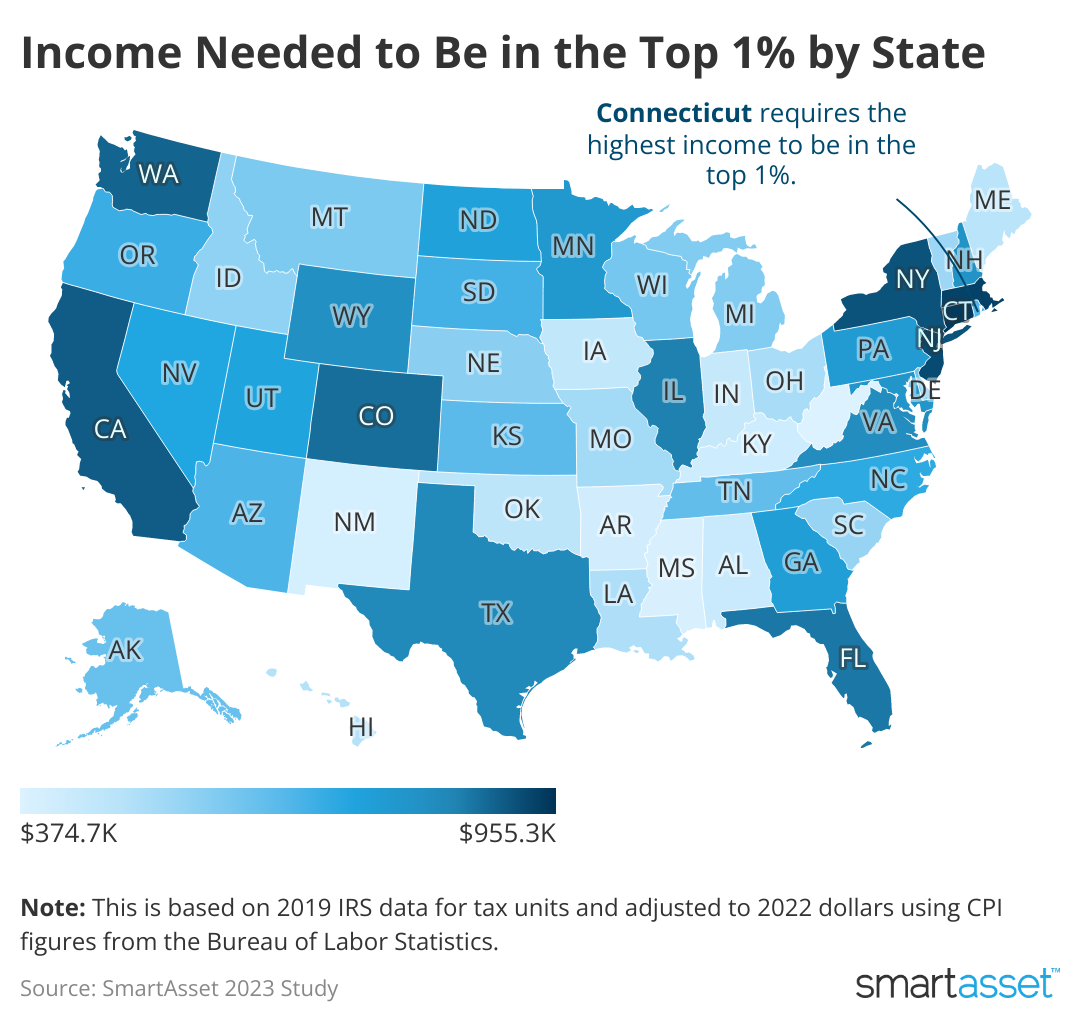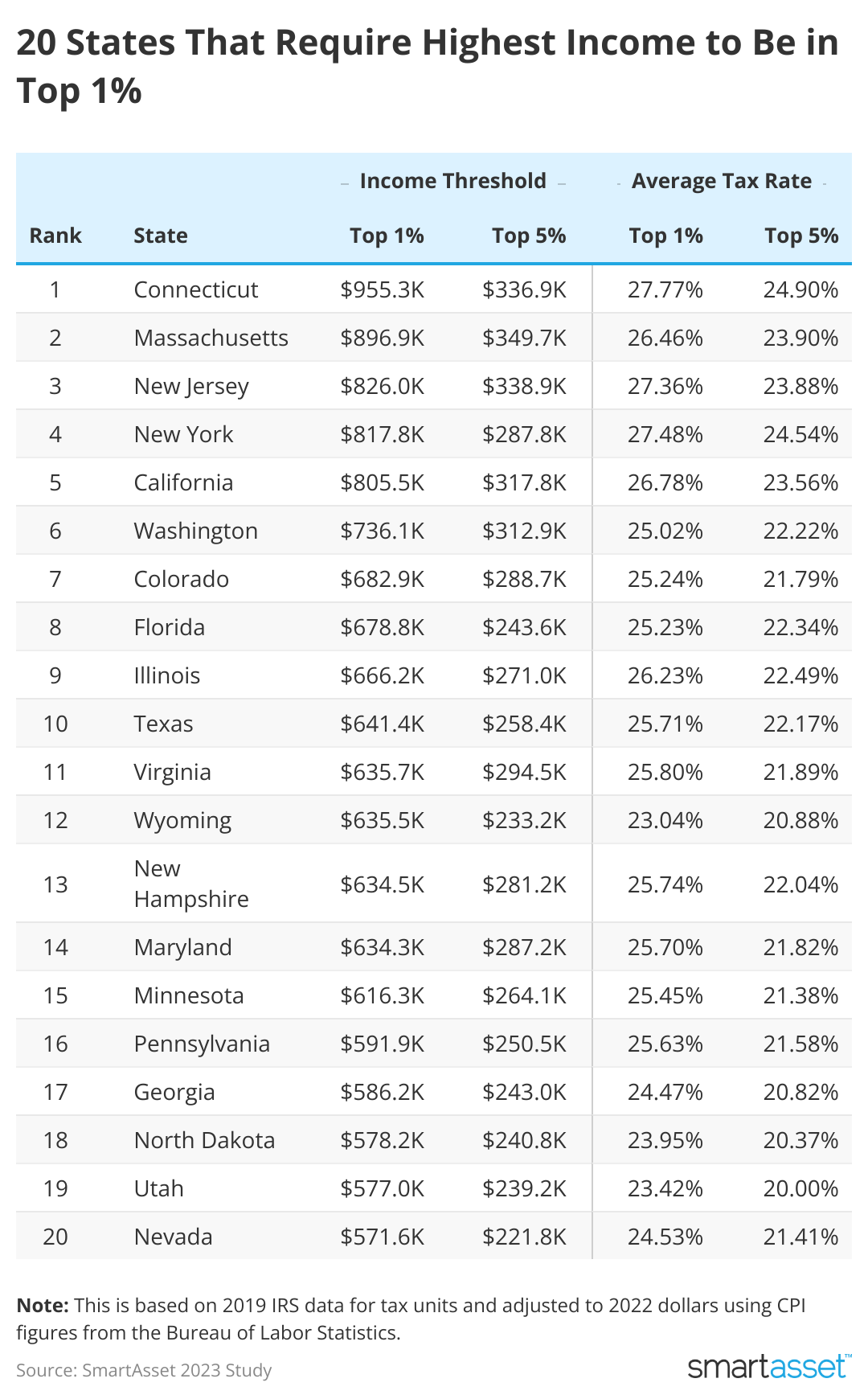What it takes to be in the top 1% of earners in each state

Canva
What it takes to be in the top 1% of earners in each state
The Hartford, Connecticut skyline as seen from the water.
The gap between the top 1% of earners and average Americans is stark. Overall, Americans have a median household income of over $70,000, but in some states, income would need to be around $900,000 to be counted among the top 1% of households. Those annual earnings can seem far out of reach in a country where less than 10% of all households earn more than $200,000, according to the U.S. Census Bureau. Ultimately, climbing the economic ladder is difficult, but it’s less intimidating in some states than in others.
SmartAsset analyzed data to determine the minimum income required to be among the top 1% of earners in each state. To do so, we used data from the IRS and Bureau of Labor Statistics. For more information on our sources and how we ranked states, read our Data and Methodology section below.
This is SmartAsset’s second study on what it takes to be in the top 1% in each state. Check out the previous edition here.
![]()

SmartAsset
States where the 1% income threshold is highest
U.S. heat map showing how much income is need to be in the top 1% in each state.
– New Jersey overtakes New York. New York ranked No. 3 in last year’s edition, with residents needing $777,126 to be a top 1% taxpayer, while New Jersey followed with $760,462. This year, New Jersey outpaces New York’s top 1% by $8,168.
– In this one state, you’ll need to earn more than $900,000 to be in the top 1%. That state is Connecticut. The top 1% of taxpayers here have the highest average tax burden (27.77%). Residents in the next highest state need roughly $58,300 less to be a top 1% taxpayer.
– Roughly $374,700 will put you in the top 1% in West Virginia – the lowest threshold across the country. Mississippi follows, where taxpayers will need roughly $383,100 to be a top 1% taxpayer. There are just 11 additional states that require less than $500,000 to be in the top 1%.
1. Connecticut
The Constitution State takes the No. 1 spot once again. Here, residents would need to earn roughly $955,000 to be in the top 1% of taxpayers. That makes it the only state requiring more than $900,000. Connecticut residents need to earn at least $336,800 to fall into the top 5%. Both groups have a tax burden that exceeds 24%, with the top 1% seeing a rate of 27.77% on average.
2. Massachusetts
Residents in Massachusetts need to earn just under $900,000 to be in the top 1% of taxpayers. This group accounts for roughly 38.12% of all income taxes paid in the state and is typically taxed at a rate of 26.46%. The income cutoff for falling into the top 5% is $547,000 less than the top 1% cutoff.
3. New Jersey
The threshold to be a top 1% taxpayer in the Garden State is $825,965. For the top 5%, the lower limit sits at $338,884. New Jersey residents within the top 5% account for 55.60% of the state’s income taxes, with the top 1% making up 33.58%.
4. New York
New York residents earning over $817,796 are considered top 1% taxpayers, while the threshold for the top 5% is much lower at $287,752. The top 1% of taxpayers in the Empire State are taxed at an average rate of 27.48%, which is the second-highest across the country. This group also accounts for 45.59% of the entire state’s total income taxes (fourth-highest).
5. California
The most populous state in the country has the fifth-highest threshold to be a top 1% taxpayer ($805,519, which is also the last state to exceed $800,000). California residents earning beyond this threshold are taxed at an average rate of 26.78% (fifth-highest) and account for roughly 39% of total income tax in the state. To be a top 5% taxpayer in the Golden State, a resident would need to earn almost $317,800.

Canva
States where the 1% income threshold is lowest
Charleston, West Virginia, as seen from the water.
Here five states where it takes the least amount of household income to be counted among the most wealthy.
1. West Virginia
As it did last year, West Virginia takes the top spot for the lowest threshold needed to be a top 1% taxpayer: $374,712. The difference between the top 1% and top 5% in West Virginia is roughly $190,700. The average tax rate for the top 1% is 23.56%, and these residents account for 27.49% of the state’s total income taxes. Comparatively, the top 5% pays an average tax rate of 18.45% and accounts for 48.03% of West Virginia’s total income taxes.
2. Mississippi
To be a top 1% taxpayer in this southern state, residents must earn at least $383,128. Additionally, Mississippi and West Virginia are the only two states where you need to earn less than $400,000 to be in the top 1% of taxpayers. For this group of taxpayers, there is an average tax rate of 22.47% and they account for just under a third of the state’s total income taxes.
3. New Mexico
New Mexico taxpayers in the top 1% account for roughly 33% of total income taxes in the state. To meet the threshold for the top 1%, a New Mexico resident needs at least $418,970 in earnings and can expect to be taxed at an average rate of 22.67%. The top 5% needs a minimum of $201,646 and pays an average tax rate of 18.86%
4. Arkansas
In the state known for diamonds, residents will need to earn at least $446,276 to fall into the top 1% of taxpayers. Those earning over $198,233 fall into the top 5%, almost a 56% difference in earnings. The top 1% of taxpayers are taxed at an average rate of 22.57%, while the top 5% can expect roughly a 19% rate. Both groups account for 58.41% of the state’s total income taxes.
5. Kentucky
Earnings of just over $447,300 are needed to be considered a top 1% taxpayer in the Bluegrass State, and just under $200,000 is required to be in the top 5%. Kentucky residents who fall into the top 1% are taxed at an average rate of 23.78% and account for just under a third of the state’s total income taxes.

SmartAsset
Data and methodology
A data table showing the 20 states that require the highest income to be in the top 1%.
To determine the income needed to be in the top 1% of earners in each state, SmartAsset analyzed 2019 data from the IRS for tax units (i.e. single, married or head of household). Figures were adjusted to 2022 dollars using the Consumer Price Index for Urban Wage Earners and Clerical Workers (CPI-W) from the Bureau of Labor Statistics.
This story originally appeared on SmartAsset and has been independently reviewed to meet journalistic standards.